Chapter: Psychology: Perception
Perceptual Constancy

PERCEPTUAL CONSTANCY
We began earily by noting that
perception seems easy and immediate—we open our eyes and see, with no apparent
complexities. But we also said that this intu-ition is misleading, because
perception involves considerable complexities—many steps to be taken, and many
points at which the perceiver must play an active role in interpreting the
input. This message emerged again and again in our discussion of how we
recognize the objects that surround us, and the same broad message—mul-tiple
steps, and an active role—emerges when we consider another essential aspect of
perceiving: the achievement of perceptual
constancy. This term refers to the fact that we perceive the constant
properties of objects in the world (their sizes, shapes, and so on) even though
the sensory information we receive about these attributes changes whenever our
viewing circumstances change.
To illustrate this point,
consider the perception of size. If we happen to be far away from the object
we’re viewing, then the image cast onto our retinas by that object will be
relatively small. If we approach the object, then the image size will increase.
We’re not fooled by this variation in image size, though. Instead, we manage to
achieve sizeconstancy—correctly
perceiving the sizes of objects in the world despite the changes
inretinal-image size created by changes in viewing distance. Likewise, if we
view a door straight on, the retinal image will be rectangular in shape; but if
we view the same door from an angle, the retinal image will have a different
shape (Figure 5.20). Still, we achieve shape
constancy—that is, we correctly perceive the shapes of objects despite
changes in the retinal image created by shifts in our viewing angle. We also
achieve brightness constancy—we
correctly perceive the brightness of objects whether they’reilluminated by dim
light or strong sun.
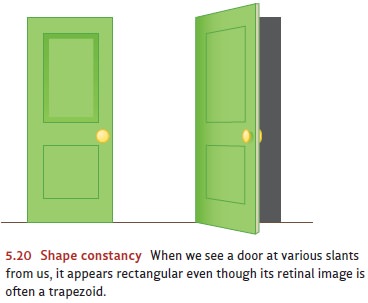
Unconscious Inference
How do we achieve each of these
forms of constancy? One hypothesis focuses on rela-tionships within the retinal image. In judging size, for
example, we might be helped bythe fact that we generally see objects against
some background, and various elements in the background can provide a basis for
comparison with the target object. Thus the dog sitting nearby on the kitchen
floor is half as tall as the chair and hides a number of the kitchen’s floor
tiles from view. If we take several steps back from the dog, none of these
relationships changes, even though the sizes of all the retinal images are
reduced (Figure 5.21). Size constancy, therefore, might be achieved by focusing
not on the images themselves but on these unchanging relationships.
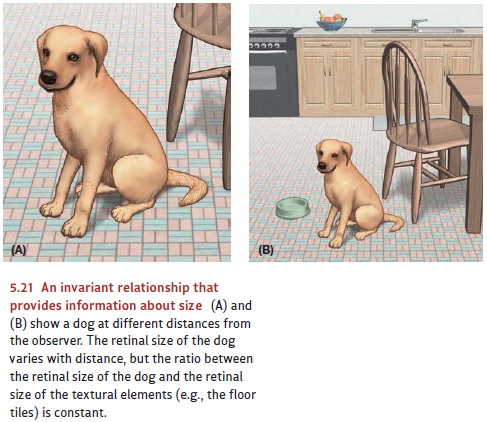
Relationships do contribute to
size constancy, and that’s why we are better able to judge size when comparison
objects are in view or when the target we’re judging sits on a surface that has
a uniform visual texture (like the floor tiles in the example). But these
relationships don’t tell the whole story. Size constancy is found even when the
visual scene offers no basis for comparison—if, for example, the object to be
judged is the only object in view—provided that other cues signal the distance of the target object (Chevrier
& Delorme, 1983; Harvey & Leibowitz, 1967; Holway & Boring, 1947).
How might our visual system use
this distance information? More than a century ago, the German physicist
Hermann von Helmholtz developed an influential hypoth-esis regarding this
question. Helmholtz started with the fact that there’s a simple inverse
relationship between distance and retinal image size: If an object doubles its
distance from the viewer, the size of its image is reduced by half. If an
object triples its distance, the size of its image is reduced to a third of its
initial size. This relation-ship is guaranteed to hold true because of the
principles of optics, and the relation-ship makes it possible for perceivers to
achieve size constancy by means of a simple calculation. Of course, Helmholtz
knew that we don’t run through a conscious calcu-lation every time we perceive
an object’s size; but he believed we were calculating nonetheless—and so he
referred to the process as an unconscious
inference (Helmholtz, 1909).
What is the calculation that
allows someone to perceive size correctly? It’s simply multiplication: the size
of the image on the retina, multiplied by the distance between you and the
object. (We’ll have more to say about how you know this distance in a later
section.) Thus, imagine an object that, at a distance of 10 feet, casts an
image on the
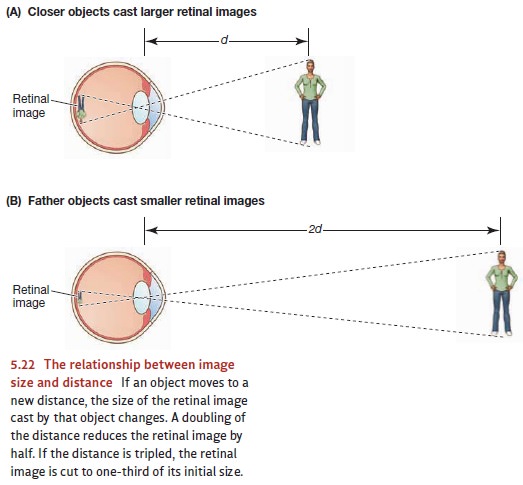
retina that’s 4 millimeters
across (Figure 5.22). The same object, at a distance of 20 feet, casts an image
of 2 millimeters. In both cases, the product—10 # 4 or 20 # 2—is the same. If, therefore,
your size estimate depends on that product, your size estimate won’t be thrown
off by viewing distance—and of course, that’s exactly what we want.
What’s the evidence that size
constancy does depend on this sort of inference? In many experiments,
researchers have shown people some object and, without changing the object’s
retinal image, changed the apparent distance of the object. (There are many
ways to do this—lenses that change how the eye has to focus to bring the object
into sharp view, or mirrors that change how the two eyes have to angle inward
so that the object’s image is centered on both foveas.) If people are—as
Helmholtz proposed— using distance information to judge size, then these
manipulations should affect size perception. Any manipulation that makes an
object seem farther away (without chang-ing retinal image size) should make
that object seem bigger. Any manipulation that makes the object seem closer
should make it look smaller. And, in fact, these predictions are correct—a
powerful confirmation that we do use distance to judge size.
A similar proposal explains how
people achieve shape constancy. Here, we take the slant of the surface into
account and make appropriate adjustments—again, an unconscious inference—in our
interpretation of the retinal image’s shape. Likewise for brightness constancy:
We seem to be quite sensitive to how a surface is oriented relative to the
available light sources, and we take this information into account in
estimating how much light is reaching the surface. Then we use this assessment
of lighting to judge the surface’s brightness (e.g., whether it’s black or gray
or white). In all these cases, therefore, it appears that our perceptual system
does draw some sort of unconscious inference, taking our viewing circumstances
into account in a way that allows us to perceive the constant properties of the
visual world.
Illusions
This process of taking
information into account—no matter whether we’re taking viewing distance into
account, or viewing angle, or illumination—is crucial for achiev-ing constancy.
More than that, it’s yet another indication that we don’t just “receive”
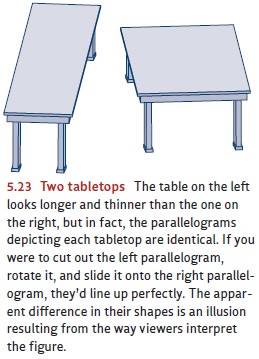
Visual information,weinterpretit.The interpretation is always
an essential partof our perception and
generally helps us perceive the world correctly. But the role of th interpretation becomes especiallyclear when we misinterpret the
informa-tion available to us and
end up misper-ceiving the world.
Consider the
two tabletops shown
in Figure 5.23. The table on the left looksappreciably longer and thinner than the one on the right; a
tablecloth that fits one table surely won’t fit the other. Objectively, though,
the parallelogram depicting the left table-top is exactly the same shape as the
one depicting the right tabletop. If you were to cut out the left tabletop,
rotate it, and slide it onto the right tabletop, they’d be an exact match.
Why do people misperceive these
shapes? The answer involves the normal mecha-nisms of shape constancy. Cues to
depth in this figure cause the viewer to perceive the figure as a drawing of
two three-dimensional objects, each viewed from a particular angle. This leads
the viewer—quite automatically—to adjust for the (apparent) viewing angles in
order to perceive the two tabletops, and it’s this adjustment that causes the
illusion. Notice then, that this illusion about shape is caused by a misperception of depth: The viewer misperceives the depth relationships in the
drawing and then takesthis faulty information into account in interpreting the
shapes. (For a related illusion, see Figure 5.24.)
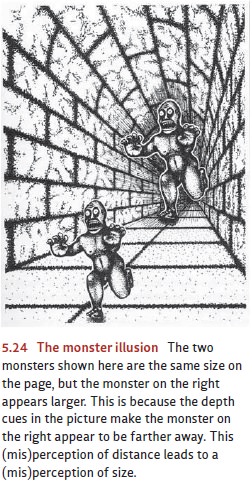
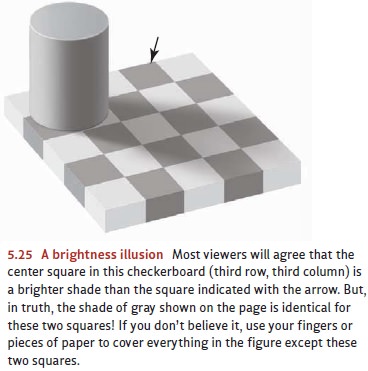
A different example is shown in Figure 5.25. It seems obvious to most viewers that the center square in this checkerboard (third row, third column) is a brighter shade than the square indicated by the arrow. But, in truth, the shade of gray shown is identical for these two squares. What has happened here? The answer again involves the normal mechanisms of perception. Notice, first, that the central square is surrounded by dark squares; this arrangement creates a contrast effect that makes the central square look brighter. The square marked at the edge of the checkerboard, on the other hand, is surrounded by white squares; here, contrast makes the marked square look darker. So for both squares, we have contrast effects that move us toward the illusory perception. But the visual system also detects that the central square is in the shadow cast by the cylinder. Our vision compensates for this fact—again, an example of unconscious inference that takes the shadow into account in judging brightness—and powerfully magnifies the illusion.
Related Topics